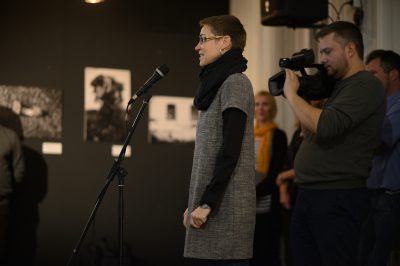The photography exhibition “On the Trail of the Danube Swabians” was on display at the Belgrade Cultural Centre Parobrod from 12 to 20 December. The authors of the exhibited photographs are Nenad Vukosavljević and Nedžad Horozović. This was a way for the Centre for Nonviolent Action to organise a multimedia presentation of the research conducted by Helena Rill and Marijana Stojčić over a number of years and published in BCSM, English and German under the same title.
The fate of the Danube Swabians is still a taboo topic in Serbia and throughout the former Yugoslavia. Memories and narratives about close to half a million citizens, who had lived in the Kingdom of Yugoslavia before the Second World War and have now all but disappeared, are simple: “Germany lost the war, all Germans supported that war, they were subsequently expelled, they got what they deserved.” This line of reasoning leaves little room for re-examination, curiosity about new information or understanding, and in the case of Serbia, not even that small space that can be evoked by simple human empathy: if not all Serbs are to blame for the wars waged in their name in the 1990s, and if they are not all to blame for the crimes committed in those wars, how come all Danube Swabians are to blame for the war waged by Germany?

Dispel the darkness
An attempt to dispel the darkness that descends once this topic is broached is accompanied by public denouncement by all those who prefer black-and-white perspectives of history, who recognise only the righteous and the guilty, and who see justice in righteous rage.
This was the atmosphere that surrounded the opening of the exhibition and presentation of the research, because on social networks voices of condemnation and even ridicule, threats and moralising were dominant. We wondered why none of the hundreds of those bothered by the opening of this topic had bothered to read the research study which is publicly available free of charge? What gives rise to such conviction in the strength of your own knowledge if you never re-examine it in light of new facts, even if you would ultimately discard them? Where did this desire come from to defend crimes committed by revolutionary authorities in SFRY, especially when expressed by those that are very much right wing and wont to calling such authorities anti-Serb commies while glorifying the collaborators of the Reich at the same time? These are questions that only the direct stakeholders can answer, primarily for their own benefit. A change in the narrative is possible only once human suffering is recognised on the “enemy’s” side.

Recognition of the victim
“I’ll never forget my time in the camp – not just because we were hungry, or because our lives were endangered every day (I remember the camp administrator who had the habit of lining us up and executing every tenth person), but because we were treated like slaves, like second-rate beings… In the camp, and for a long time afterwards, I would dream about having a piece of bread, being free to go where I like, without an escort and without fear.” These are the words of Anne Koch, a survivor from the detention camp for Danube Swabians in Gakovo whose daughter, Ana Bu, born in the camp, attended the exhibition opening and spoke about how important it was for her personally to see this topic finally discussed within her lifetime.
Helena Rill, one of the authors of the research study, found motivation to deal with this topic in her family history and ties to the Second World War and its aftermath. On the one hand, her mother had been in a camp in Germany during the war and this was talked about. What was not talked about was her father’s national identity and what had happened a few years after the war, when his entire immediate family moved out of Yugoslavia. “It is important to recognise the victim. But how is going to recognise my victimisation of being sent to a camp when I was little, just because I was German?” wondered the doctor of Helena’s mother, which led Helena to research this particular unpopular victimisation, as she said at the exhibition opening.
Nedžad Horozović also spoke about his personal experience as a refugee, during the war in Bosnia, and how easily people forget those that had been their neighbours only yesterday.
Guido Stein from the Apatin Community in Germany was a guest at the opening and he had travelled to Belgrade for that express purpose. His mother is a German from Apatin and it was very important to him, as he said, to find out more about what had happened, about events that are still enveloped by a loud silence, as pointed out by historian Zoran Janjetović who contributed to the research.
The exhibition was officially inaugurated by Johannes Irschik, director of the Austrian Cultural Forum from the embassy in Belgrade.
Although it may seem immodest coming from us as the organisers, we were surprised by the number of visitors who had found out about the exhibition in various ways, but it seemed they all had very personal motivation to come. They were either motivated by intellectual curiosity and wanting to find out more, or they were descendants of Danube Swabians who wanted to fill in the often fragmented and convoluted family narratives that where only ever uttered quietly and imprecisely. A point of interest: when we were preparing the exhibition and while it was on display, it seemed that at every corner, in every conversation, we would run into people who knew or were related to a Danube Swabian. In the hope that the research and the exhibition have opened up at least a small space for light to come through and dispel the darkness of silence, we believe this exhibition will be just the first in a series to follow.